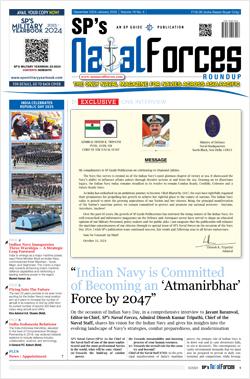INDIAN ARMED FORCES CHIEFS ON OUR RELENTLESS AND FOCUSED PUBLISHING EFFORTS

The insightful articles, inspiring narrations and analytical perspectives presented by the Editorial Team, establish an alluring connect with the reader. My compliments and best wishes to SP Guide Publications.

"Over the past 60 years, the growth of SP Guide Publications has mirrored the rising stature of Indian Navy. Its well-researched and informative magazines on Defence and Aerospace sector have served to shape an educated opinion of our military personnel, policy makers and the public alike. I wish SP's Publication team continued success, fair winds and following seas in all future endeavour!"

Since, its inception in 1964, SP Guide Publications has consistently demonstrated commitment to high-quality journalism in the aerospace and defence sectors, earning a well-deserved reputation as Asia's largest media house in this domain. I wish SP Guide Publications continued success in its pursuit of excellence.
- MoD initiates comprehensive review of Defence Acquisition Procedure 2020, pushes for defence reforms
- G7: The Swansong
- Kalinga Connect: South Asia to Polynesia
- Advanced MRSAM for India for a greater firepower
- Must Credit DRDO for Operation Sindoor, now what is next for defence R&D?
- Operation Sindoor | Day 2 DGMOs Briefing
- Operation Sindoor: Resolute yet Restrained
Navy Adds 3 Warships
Commissioning of these three naval platforms is being called a timely response to Pakistan Navy's accelerated, China-backed modernisation. But at the same time, India does have some catching up to do.
 |
The Author is Former Director General of Information Systems and A Special Forces Veteran, Indian Army |
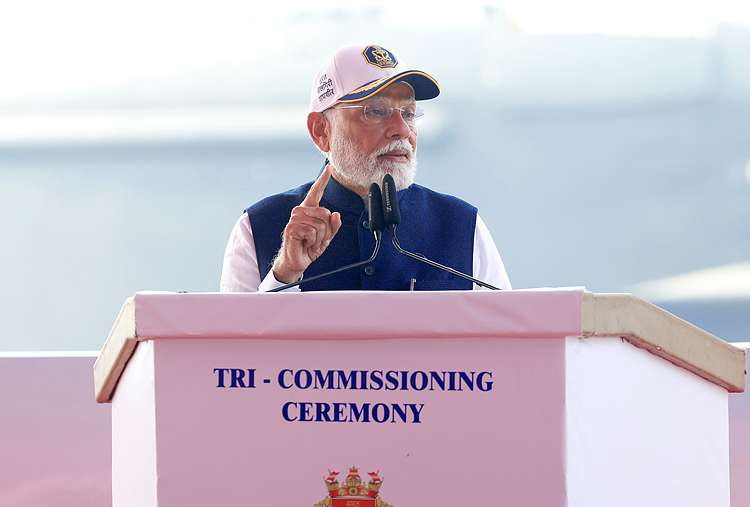
In a first in the history of the Indian Navy, Prime Minister Narendra Modi commissioned three frontline naval platforms into the Indian Navy on January 15, 2025 - INS 'Nilgiri', INS 'Vaghsheer' and INS 'Surat' were commissioned on the same day. All the three vessels have been manufactured at Mumbai's Mazagon Dock Shipbuilders Limited. The level of indigenisation on all the three platforms is more than 70 per cent. Hailing the first tri-commissioning as a significant leap towards 'Atmanirbhar Bharat', Prime Minister Modi dedicated the three vessels to the nation. INS Nilgiri is the lead ship of Project 17A frigates, INS Vaghsheer is the sixth and the final boat of Project 75 Kalvari class submarines, and INS Surat' is the fourth and final ship of Project 15B destroyers.
This is the first time that the tri-commissioning of a destroyer, frigate and submarine is being done on the same day
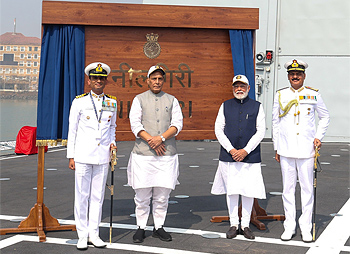
Speaking at the commissioning ceremony at the Naval Dockyard, Prime Minister Modi said, "Chhatrapati Shivaji Maharaj had given a new vision to the Navy. Today, this is a significant step towards empowering the Indian Navy of the 21st century. It is a big day for the 'Atmanirbhar Bharat' vision. It is a massive step for strengthening our Navy. This is the first time that the tri-commissioning of a destroyer, frigate and submarine is being done on the same day. The Make in India campaign connects our needs to our future vision. We are becoming a major maritime power by taking inspiration from our rich naval history. INS Nilgiri is dedicated to the naval empire of the Cholas. INS Surat is dedicated to India's ancient connection to West Asia through Gujarat. I was there at the commissioning of the first Kalvari submarine. I am blessed to commission the sixth one – INS Vaghsheer."
Prime Minister Modi highlighted how domestic warship construction creates employment opportunities and noted that 60 large vessels worth about 1.5 lakh crore were being constructed
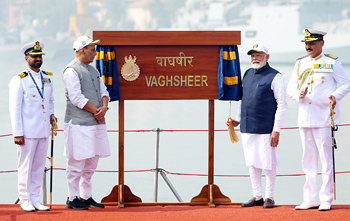
With January 15 being observed as 'Army Day', Prime Minister paid tributes to soldiers safeguarding national security. The ceremony saw attendance from governor C.P. Radhakrishnan, Defence Minister Rajnath Singh, Union Minister of State (MoS) for defence Sanjay Seth, Chief Minister Devendra Fadnavis and both Deputy Chief Ministers of Maharashtra. Modi highlighted how domestic warship construction creates employment opportunities and noted that 60 large vessels worth about 1.5 lakh crore were being constructed. He emphasised the need to protect territorial waters, ensure navigational freedom, and secure trade routes for economic growth and energy security. He congratulated the Navy and all the stakeholders involved in the construction of these three naval platforms.
Indian Navy doesn't operate a single AIP-equipped submarine yet, while Pakistan Navy's all three French Agosta-90B (PNS Khalid, Saad, and Hamza) are powered by AIPs
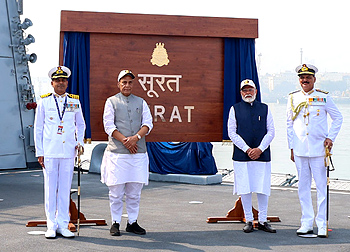
Commissioning of these three naval platforms is being called a timely response to Pakistan Navy's accelerated, China-backed modernisation. But at the same time, India does have some catching up to do. For example, the Indian Navy doesn't operate a single AIP-equipped submarine yet, while Pakistan Navy's all three French Agosta-90B (PNS Khalid, Saad, and Hamza) are powered by AIPs. Moreover, the Hangor submarines are expected to join the Pakistan Navy by the late 2020s and early 2030s; taking the Pakistan Navy's AIP-equipped submarine fleet strength to 11. Pakistan also plans to enlarge its surface fleet to 50 warships along with a subsurface fleet of 11 submarines. Of the 50 surface ships the Pakistan Navy wants 20 major surface vessels like frigates and corvettes. Construction of four of these submarines is progressing as per the timeline.
In December 2021, the fifth Hangor-class 'conventional' submarine, also the first one to be built in Pakistan, had the steel cutting ceremony. The Hangor submarines are S-26 variants based on the Chinese Yuan class submarines but developed for exports. Several design changes were made to the standard-grade S-26. Earlier, the S-26 submarines were powered by the German MTU 12V 396 SE84 diesel engine, but the German government reportedly withheld export licenses for the powerplant. Later, the Pakistan Navy decided to go with the Chinese CHD-620 diesel engine, delaying the programme. AIP-powered conventional diesel-electric submarines (SSK) are between nuclear-powered boats and non-AIP SSKs. It allows an SSK to remain submerged for 10-14 days without needing to surface to charge its batteries, which might get it detected. Other SSKs can stay underwater for roughly 48 hours.
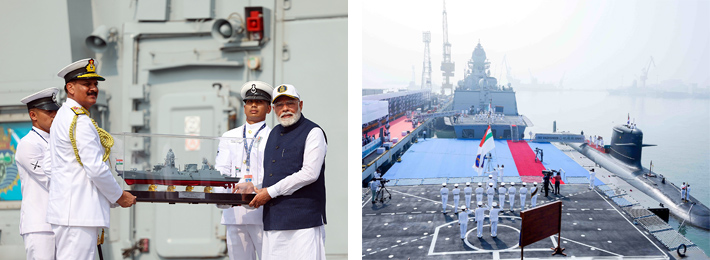
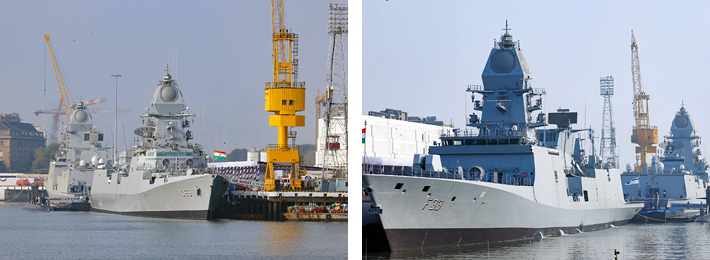
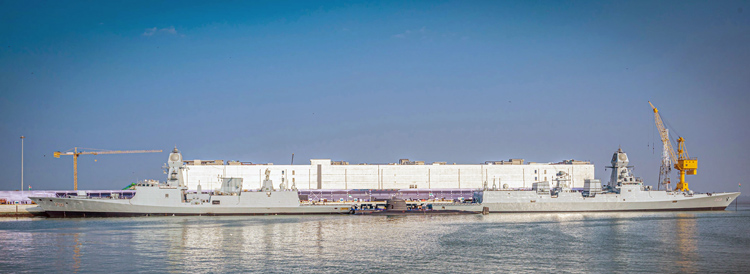
With the induction of INS Vaghsheer, the Indian submarine fleet currently has 17 conventional submarines. The Scorpene Class submarine is to be retrofitted with an indigenous AIP system when the first submarine in the class, INS Kalvari, undergoes major refit, with assistance of French shipbuilder Naval Group. Thereafter, the technology will undergo further testing before being fitted into the remaining Scorpene-class submarines. Some experts say that that upgrading a weapons platform with new technology will reduce operational readiness, as the repairs will take at least one year. The Indian Navy is also scouting for a foreign vendor to build AIP-equipped submarines under Project-75(I). Although Spain and Germany did offer their systems for trials, Project 75(I) continues to face hurdles as Indian Navy's AIP requirements remain unmet by Spain's Navantia and Germany's ThyssenKrupp Marine Systems (TKMS) submarine trials. Notably, submarines to be built under Project 75(I) will likely take a decade plus to enter the Indian Navy considering it took 11 years for the first Scorpene class submarine to enter the Indian Navy's fleet after signing the deal.
In a recent unfortunate mishap, a Drishti 10 Starliner drone costing, built by Adani Defence and Aerospace at a cost of ₹145 crore, crashed off the Porbandar coast ahead of delivery to the Indian Navy. According to media reports, the drone lost control mid-flight and plunged into the waters, raising concerns about its operational reliability. The Navy has already deployed one Drishti 10 Starliner drone, which was inducted earlier. Both the Army and the Navy had ordered two each of these drones, using emergency funding powers to improve their intelligence, surveillance and reconnaissance (ISR) capabilities.





